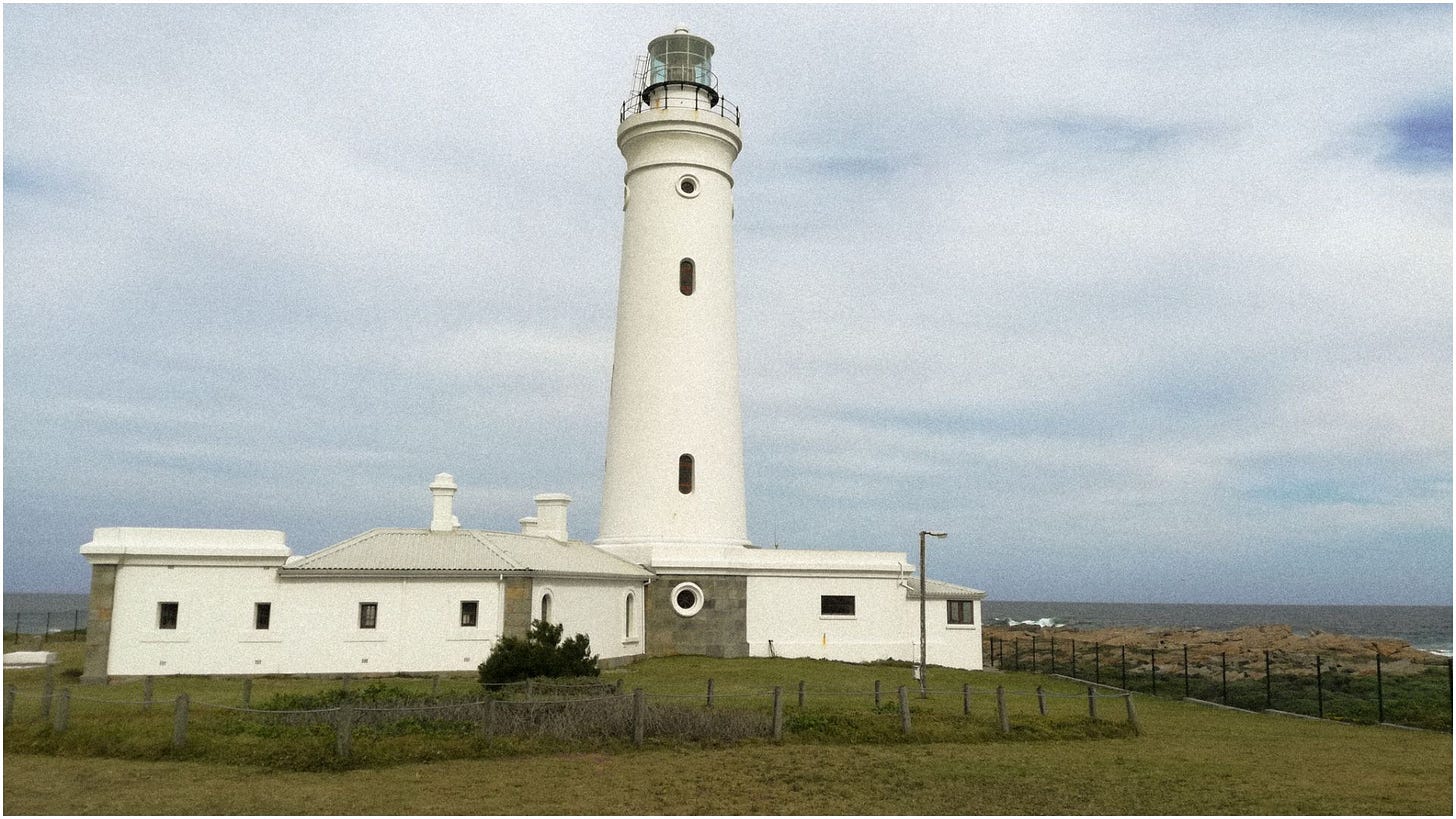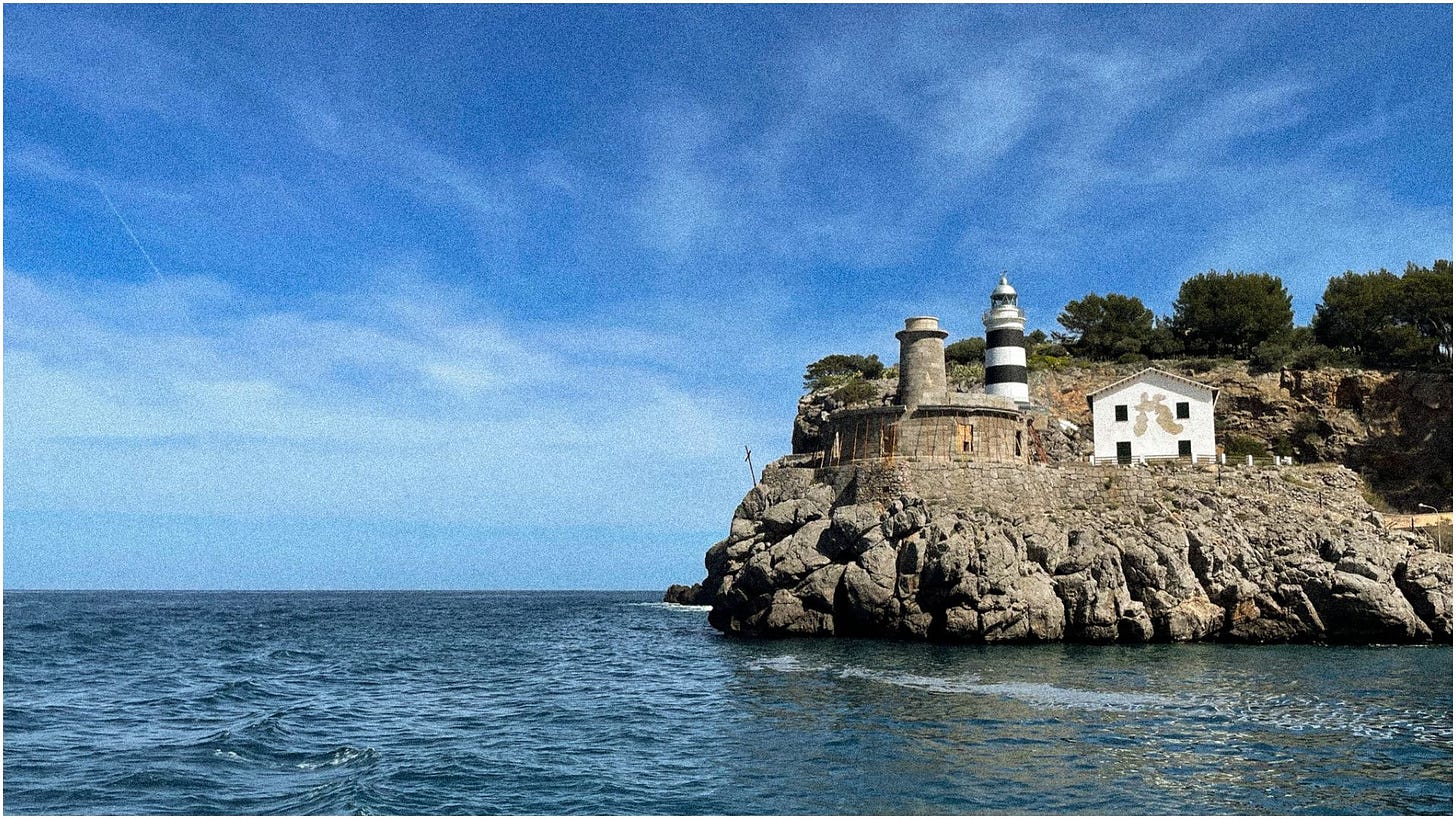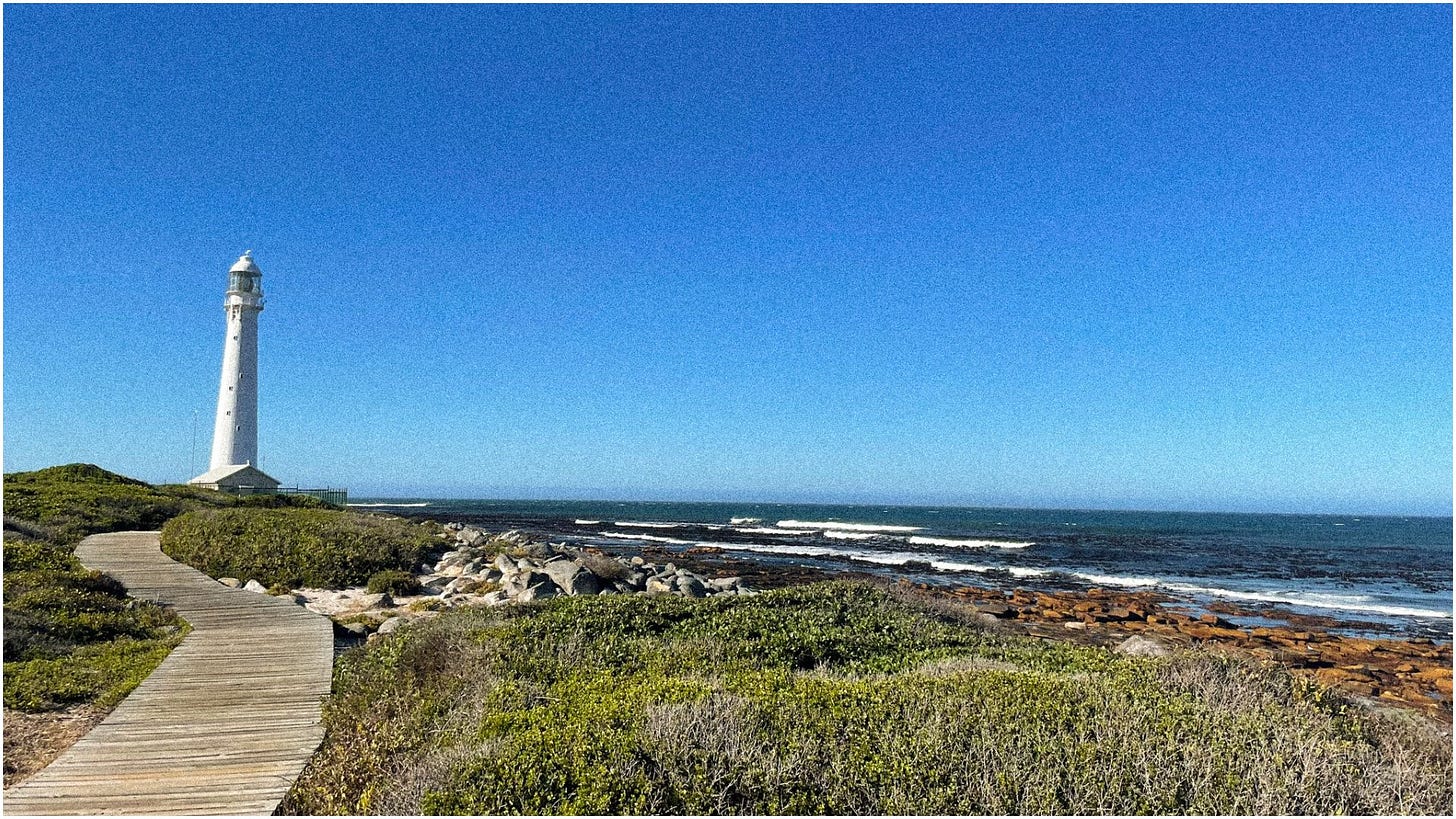A Call to Other Lightkeepers
To those who want to keep a network of lights going in a sometimes very dark world.
I’ve always been drawn to the image of the lighthouse. A stoic sentinel on the shoreline that has guided countless souls throughout the centuries. The lighthouse stands tall at the centre of the primordial chaos that is the meeting of elements. It holds its ground on the rugged coast, battered by unruly waves and shaken by ever-changing winds, all while maintaining its steady light. A setting that evokes a tale as old as time - earth and water clash as air and fire dance. How can one not fall in love with the imagery?
The Guiding Beacon
When we think of a lighthouse, it is often the solitary structure itself that first comes to mind. As land dwellers, we see it on the shoreline, its commonly striped-tower standing out against the natural backdrop that surrounds it. The early structures were called by their Greek name, pharos, a term semantically related to the word 'beacon'. The earliest known lighthouse is the Pharos of Alexandria (a wonder of its time), believed to have served as a beacon for over 1500 years.
And it is this visual presence that makes the lighthouse such a powerful symbol. As Virginia Woolf explored in To the Lighthouse, it represents both profound loneliness and an essential interconnectedness. It is simultaneously an embodiment of isolation and a vital node along an extensive communication network. It stands alone, with a purpose that is entirely for the benefit of others.
Veronica della Dora describes our imaginings of lighthouse and lightkeepers in Where Light in Darkness Lies, "Like the distant light of the lamp burning through the window of the hermit’s hut, the lighthouse radiates warmth. It conjures up the image of a solitary who keeps vigil while the world is asleep. It is at once a guiding light and a refuge." She goes on to say that, in a way, the lighthouse feels like something that is entirely human and somewhat metaphysical, at the same time.
The lighthouse is seen to provide stability in the unstable, a known place in unknown times. It is a structure designed not to fight the elements, but to deflect them, allowing the wind and waves to flow easily over its rounded shape. Its very existence is a testament to resilience, a fixed point of reference in a cartographic sea of uncertainty. But it is the lightkeeper who makes it so. And recently, my thoughts have returned more and more to the keepers of lighthouses. The ones who tended the flame, who kept watch, and who maintained the light even when smothered by storms and blanketed in fog. They were the custodians of safety and caretakers of a place few would ever venture, let alone know.

The Keeper’s Wisdom
The life of a lightkeeper was undeniably hard. As described above, the lighthouse was a symbol of safety and protection for others, but could also be an isolated prison for its keeper. And yet, for many a keeper, this isolation and solitude became one of their best teachers. They learned to read the sky, to predict the moods of the sea, and to know the unseen dangers of shallow reefs and sandbanks. The wisdom of a keeper wasn't found in books, but in the elements themselves. Their wisdom was born of private vigilance, of patient observation, and of a fierce self-reliance amongst the seas, storms, and stars.
To keep a lighthouse was to be in constant service. Lightkeepers rose with the tides and worked by moonlight. They trimmed wicks, polished lenses, and wound clockworks. Before automated weather stations, they meticulously recorded cloud cover, wind direction, and barometric pressure. They maintained logs as ritual more than routine. Everything observed (birds, ships, storms) mattered.
Lightkeepers also had to be skilled in many trades: part engineer, part meteorologist, part mariner. They had to know the coast intimately, from how waves behaved on a full moon, to when the fog usually rolled in, and what a sudden hush in the wind might mean. But perhaps the most philosophical part of the work was its slowness. Having helped in a coastal geomorphology study, I know it can feel like time moves differently when it’s marked by tides instead of day planners. There was intentionality and presence in their work and way of being. And like the lighthouse, lightkeepers lived with the environment rather than trying to fight it.
Lighthouses, But No Keepers
By the mid-20th century, change began to creep in. As technology advanced, the justification for full-time lightkeepers began to erode. One by one, countries began phasing them out. Electric lamps replaced oil-burning ones, solar panels and backup batteries reduced the need for fuel deliveries, and remote monitoring from hundreds of kilometres away made present human keepers unnecessary. By the early 2000s, most lighthouses worldwide operated without permanent residents.
And sure, there were clear and undeniable benefits: costs were lowered, risks during supply deliveries were gone, dangers to the keepers eliminated, and consistent operation was ensured. From a practical standpoint, the transition made sense.
And when I say what I’m about to say, it is neither a push against progress nor am I implying that automation is inherently bad. I wouldn’t want keepers to face the life-threatening pressures they once did. All I am asking us to sit with is: what do we lose when jobs that were more like relationships with the natural world than tasks are brought to an end? The story of the lightkeepers is one we’ve been told across many professions: shepherds who read the hills like unending stories are replaced by drones, farmers who understand the weather better than satellites are replaced by industrial machinery and generalised agricultural guides, postal workers who know and are known in their communities are replaced by digital mails.
Imaginably, I am being hyperbolic when I say that lighthouses and their keepers were symbols of guardianship, and now they simply mirror surveillance (precise, insistent, soulless). It feels like another lost human connection to the wild, liminal spaces of our world. Technological advancements bring much loved efficiency and accustomed to convenience in our ever-more-becoming frictionless world. But it also brings further disconnection between humanity and nature.
The wisdom of these professions came from immersion, learning the secrets whispered by landscape to those who listen. I completely understand that farmers’ lives are easier with machinery, and lightkeepers can find safer employment. I guess, I am simply trying to express my despondency in the constant loss of a deep, human connection to the land, sky and sea… of stewardship in favour of surveillance. The lives of the keepers, with their patient presence and selfless dedication to their guardianship, should remind us that slowness and deep connection to nature must always have their place.
The Light in the Darkness
Of course, the most elemental part of a lighthouse is the light itself. A single flame is small and fragile, easily extinguished. But when that light is reflected and amplified through a series of carefully crafted lenses, it becomes a powerful beam that can cut through the darkest night and thickest fog.
Early lighthouses shone a constant light, but wrecks still occurred because it could be mistaken for a passing ship. And so the revolving light, with a set rhythmic period of revolution, was introduced to help distinguish the lighthouse light from ships (with the added benefit that changing visual stimuli also helps draw the eye more easily).
A subtle and sincere reminder for us: showing up constantly doesn’t mean burning endlessly, and it isn't what's needed. Rest. Return when you find your rhythm. And trust others to find their own way.
When the Dark is the Light
There is, of course, a natural duality in light and dark, but sometimes the darkest dark can show themselves as false lights. Humans love binaries (light and dark, good and evil, truth and illusion) because they give structure to our moral and existential understanding. So, what happens when the most dangerous kind of darkness disguises itself with a mask of light? In The World's Lighthouses: From Ancient Times to 1820, the history of lighthouses includes “wreckers”. Murderous marauders who would shine lights to lure ships to their doom, plundering the wrecks with little care for the affected sailors.
A chilling reminder that not all guidance is pure. Today’s “wreckers” look like the noise of social media, the lure of easy answers over critical thinking, and the deceptive gleam of unverified information. It masquerades as clarity, as moral high ground, as spiritual insight. Its calls are of comfort, not fear.
A good lightkeeper and seafarer must learn to discern between a true beacon and a deceptive glimmer, for even today not all lights lead to safe passage or safe harbours. And this discernment can come from an interrogation of the light within us. Why do we seek the truths we seek? Are they liberating, or are they comforting? Are they hard-earned insights, or attractive lies?
Darkness isn’t always where we expect it. We need to remember that true light rarely shouts, and it’s not there to flatter. It humbles, it challenges, and it transforms. And almost always, the path to it leads us through the darkness, not away from it.

Tending Your Inner Light
And this brings us to the heart of this newsletter: You are the keeper of your own light. In this newsletter, I hope to discuss creating your own safe lighthouse, staying soft and warm in a hardening, stormy world, tending to your inner flame, and staying true to yourself even as the weather around you shifts. The lighthouse and lightkeeper being the guiding metaphor. Like the lightkeeper, we can only be a beacon for others by first ensuring our own light is strong and true. We can embrace our moments of necessary solitude, finding our strength in them, and then, with purpose, let our light shine.
My faith in humanity surges like the high tide and retreats like the low tide. And yet, despite the darkness of the internet and real-world inhumane acts, I still want to be a light. Always. And I want to keep the network of lightkeepers operating. This newsletter is my call to other lightkeepers.
You are not alone in your work, and your work is needed. Together, we can continue the role of lightkeepers in real world ways, being beacons of light for passers by. Subscribe to this newsletter if this interests you. If this type of light is not for you, I wish you continued safe travels. Either way, thank you for reading and sharing your time with me.
May your flame burn steady and true. May you always find a genuine light to guide you through dark or unknown waters until you find safe harbour. We are all keepers of the same light. Share yours with someone else today to keep theirs burning – a compliment, a message of hope, a random act of kindness, a call with a loved one. And think of one way you can protect your flame today.
Books:
Della Dora, V. (2022). Where Light in Darkness Lies: The story of the lighthouse. Reaktion Books.
Stevenson, D. A. (2013). The World's Lighthouses: From Ancient Times to 1820. Courier Corporation.
Videos:
Philosophy Coded YouTube: The Terrifying Theory of Stupidity You Were Never Meant to Hear – Dietrich Bonhoeffer

